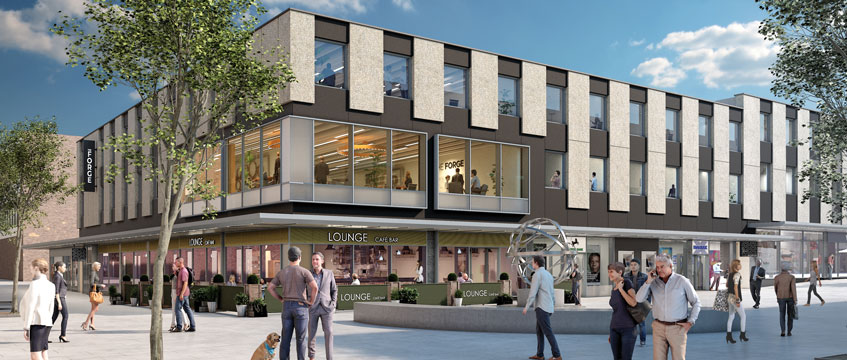Town centres and high streets are struggling, their properties often neglected or vacant. And for all the talk of regeneration and redevelopment, private-sector investors have not yet revealed themselves as the saviours once hoped for. Where else to look? Enter acquisitive, and innovative, local authorities.
Since 2013, councils have spent roughly £7.5bn on commercial real estate, according to analysis from Radius Data Exchange. The number of individual deals has increased year by year during that time and the annual value of such deals has rocketed since 2016 (see chart).
The trend is not without its critics. Over the past seven years almost 30% of all council investment in commercial property has been outside of their own jurisdictions. That does little to placate detractors who bemoan local authorities ploughing millions of pounds of public money into assets hundreds of miles outside of their boundaries. And it is inarguable that, for many councils, these punts on property are first and foremost an effort to fill their coffers with revenues lost to funding cuts.
But not for all. Leaders within several councils argue that their purchase of shopping malls and community centres are all that stands between a brighter future for local communities and yet more abandoned properties that risk turning whole areas into ghost towns.
Regeneration not revenue expansion
Ashford Borough Council was one of the first local authorities to take the plunge. Back in 2015 the council bought Park Mall, a failing shopping centre in the town with vacancy rates of 30%, for £800,000.
“If we don’t intervene, no one else will,” says Tracey Kerly, Ashford Borough Council’s chief executive, of such deals. “We knew that retail was changing, and we knew what had to be done.”
The council has transformed the property, introducing the Made in Ashford incubator and offering space for handmade clothing and crafts entrepreneurs, who can open their own stores with financial backing from the council.
Hannah Clayton-Peck, Ashford’s town centre regeneration manager, says community has been at the heart of plans for assets the council has purchased. “The high street must remain indigenous,” she adds. “We want regeneration, not gentrification.”
In Banbury, Oxfordshire, Cherwell District Council is similarly trying to create a new, better-connected vision for its town centre. Two years ago the council bought the town’s Castle Quay shopping centre for £58m from Aberdeen Standard, with the ambition of using the site to draw together the rest of the town. Since then the authority has bought several more assets along a corridor between the centre of town and the train station. That route is currently, by the council’s own admission, convoluted and confusing.
“The council is delivering on its vision to regenerate the town centre of Banbury,” says Chris Hipkiss, property and investment consultant for Cherwell District Council. “That is enabling it to continue attracting further investment and helping us to benefit the wider district.”
Mindful of criticisms of these kinds of deals, councillor Tony Ilot says the local authority’s approach to acquisitions is “not one of revenue expansion”, adding: “We are only investing in our jurisdiction. We want to invest in our town centre and our community.”
Mark Robinson, co-founder of investment manager Ellandi, suggests that collaboration between public and private sectors will be vital in future proofing properties. “Well-informed debate about what councils are doing must happen,” he says.
Robinson has worked with various councils on regenerating regional malls. The focus, he says, has been on “removing redundant retail stock, replenishing it with community, health and outreach centres, as well as co-working spaces, to create something greater than what was there before”.
Beyond the 9 to 5
As one of the UK’s first new towns, Stevenage is in a unique position when it comes to repurposing and regenerating space.
Stevenage Borough Council is leading a huge regeneration project, having set up the Stevenage First partnership alongside Local Enterprise Partnership, Herts County Council and the Chamber of Commerce. In total, £1bn is expected to be invested in the town over the next 20 years.
“We are trying to do three things: drive investment, drive footfall and improve the evening economy so that more people are using the town centre outside of core working hours,” says council leader Sharon Taylor.
The town centre was initially designed as “a traditional 9 to 5 shopping precinct”, Taylor says, with limited homes, restaurants and bars. “That is now seen as an outdated approach,” she adds. “It was all built more or less at once, with the result that everything has aged at the same time, leaving the central spaces requiring investment.”
Stevenage has evolved its blueprint from a combination of independent and government-led enquiries into the health of the high street. “We are basing [the development] on the same ‘mixed-use’ principles that are aligned with studies like the Grimsey Review,” says Taylor. “[We understand] that town centres must offer a range of uses in the same spaces. By having more people living and working in the town we can drive greater demand for services based here now and in the future.”
Whether councils’ spending sprees will continue to grow at the rate seen in recent years is unclear. Since the increase of interest rates on the loans issued by the £95bn Public Works Loan Board last year, some councils have paused for thought when continuing the relative spending splurge. The government has also said it is exploring measures to block council borrowing to back commercial real estate “for yield”, in favour of social housing and infrastructure.
This will apply to any local authority planning any debt-for-yield scheme anywhere in their capital plans, including any local authority-owned company or joint venture.
We need to ask ourselves if we are getting in the way of private enterprise. We tried to create a market for investment, and I believe that we have
– Tracey Kerly, Ashford Borough Council
It defines investment assets bought primarily for yield as those acquired to let out at market rate, previously operated on a commercial basis and continued by the local authority without investment and assets other than housing which generate income and are intended to be held indefinitely.
The PWLB advanced 1,308 new loans totalling £9.1bn during the 2018-19 financial year. This has nearly doubled on the previous year, when it issued 780 loans totalling £5.1bn.
Spelthorne Council grabbed attention in late 2019 when two mooted purchases were revealed that would have taken it past the £1bn mark in total property investment. Ultimately, says council leader Ian Harvey, the risks were seen as greater than the rewards.
“Interest rates were becoming more volatile plus the actual net margin that we work on is ultimately extremely slim,” Harvey says. “Both sellers were seeking a high purchase price against the yield which squeezed that even further and in the case of Cheapside, when I became aware that in fact we weren’t buying a freehold and only a long leasehold was available, I got even more nervous.”
Other public leaders are starting to wonder whether they are in fact crowding out private investors who may be considering a return to the market. “Our intervention may now cease,” says Ashford council’s Kerly. “We need to ask ourselves if we are getting in the way of private enterprise. We tried to create a market for investment, and I believe that we have.”
To send feedback, e-mail james.child@egi.co.uk or tweet @JamesChildEG or @estatesgazette











